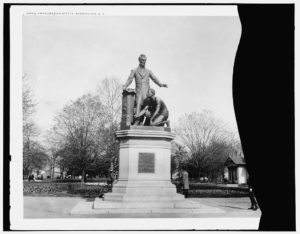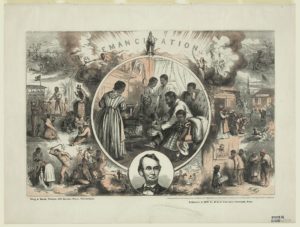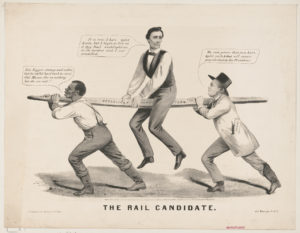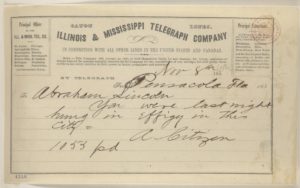Some people, who attended a memorial service for Abraham Lincoln in Wrentham, Massachusetts on the day of his Washington, D.C. funeral, weren’t too happy with what they saw when they left church.
From The New-York Times December 30, 1867:
Damages Awarded a Massachusetts Man who Rejoiced at President Lincoln’s Death and was Assaulted.
The Boston Advertiser gives a summary of a trial of some interest in the Superior Court of Norfolk County, Mass., on Thursday and Friday last. [It] was the case of PATRICK KENNEDY vs. HENRY RATHBUN, et al., viz.: … [eight others] … all of the town of Wrentham. The facts are as follows: at noon on the 19th of April, 1865, the day of President LINCOLN’s funeral, the people of Wrentham assembled in church to pay their tribute of respect to his memory. After the services were over, in full view of the church there was seen an effigy hanging, upon which was inscribed the name of “ABRAHAM LINCOLN, the nigger worshipper.” This effigy one PATRICK TRAVIS (who had put it up) was found lashing and beating in derision. The people were maddened and rushed after TRAVIS, who fled to the residence of a Mr. FISHER, from whose attic he was taken and afterward ridden on a rail for a considerable distance. While this was going on, a part of the mob went to the farm of Judge WILKINSON, where PATRICK KENNEDY was at work. He had been heard to say he was glad that LINCOLN was dead, and upon questioning him he admitted the charge. He was taken from his work, carried to the crowd who had TRAVIS, and both were rode on the rail together by the people, some 200 in number, after which they were put in the town lockup for safety, but were soon released.
The witnesses for the prosecution stated the facts in detail, by which it appeared that there were a large number engaged in the affray, among whom were many women, who flourished over the bodies of KENNEDY and TRAVIS whips of hazel and willow, which they complained made them smart. A negro, several testified, aided in the work, and called upon Kennedy to give three cheers for the flag. The witnesses for the defence did not differ much about the main statements, the discrepancy being mainly as to the part each defendant took in the transactions, one or two contending that their presence and efforts were mainly for the purpose of protecting KENNEDY and TRAVIS from serious bodily harm and to rescue them as soon as possible from the mob who had them in their hands.
The case was ably argued, after which the Court briefly charged the jury, stating that the law clearly held that where parties were present in transactions of this nature, if they helped to swell the movement by action or word, they would be liable. There were different degrees of guilt. If parties were present trying to [dissuade?], that should be taken into account. As to the damage, the defendant could recover for damage to his person, and for pain of body or distress of mind arising from the indignities heaped upon him. To jury of twelve men the subject was now committed. The Court could not, from the delicate nature of the subject, indicate what the amount of the damage should be, but if the jury agreed upon any, it should be such a sum as in the united judgment of all they could stand by. After further caution to discriminate between the innocent and the guilty, the jury retired to make up their verdict. After being out five hours the jury returned a verdict for the plaintiff, discharging two of the defendants – Messrs. FELT and MUNROE – from any complicity in the affair, and assessing damages upon the other seven to the amount of $185. KENNEDY brings the action in his own behalf, TRAVIS not being in the case.
Abraham Lincoln was familiar with riding the rail – according to several 1860 political cartoons. Two days after his victory in the presidential election a telegram was sent to him saying he was being hung in effigy in Pensacola, Florida.




